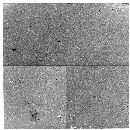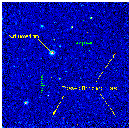NICS imaging modes
Optics
The instrument is equipped with two cameras which are permanently mounted on a wheel inside the cryostat and can be quickly (~1 minute) interchanged during the night. All optics are refractive (i.e. lenses) and consist of a CaF2 entrance window and a BaF2+IRG2 collimator which produces a 22mm collimated beam which is reimaged on the array either by the LF (2 BaF2 + 2 IRG2 lenses) or by the SF (1 BaF2 + 2 IRG2 lenses) cameras. All the optical elements have been manufactured by Janos Technology and have multi-layer anti-reflection coating especially designed to minimize light losses within the wavelength regions of good atmospheric transmission. The overall transmission of the optics can be visualized in this figure.
Fields of view
|
The large field camera (LF) offers a quite large field of view with a pixel scale small enough to properly sample the images under normal seeing conditions. Thanks to the NICS refurbishment of Feb-Mar 2003, the optics are now much better aligned and the image PSF is virtually constant over a diameter of 4' The LF images are also characterized by a significant pin-cushion distortion which is intrinsic to the optics design and amounts to 1% at the edges and 3% at the array corners. This effect is wavelength independent, can be accurately modelled and corrected for during the image reduction using e.g. the drizzle routine. This correction is included in the SNAP reduction package The small field camera (SF) is primarily intended for imaging programs requiring a fine sampling of the point spread function. It has a superb optical quality with negligible field distortion. |
||||||||||||
Filters
|
The instrument is equipped with a number of broad and narrow band filters which are listed in the table on the side. Their transmission curves are displayed in this figure. More details on each filter, including numerical files with efficiency values measured at the operational temperature (78 K), can be obtained by clicking on the filter name in the table. The SW filter is mainly intended for the quick detection of faint sources while it is not suitable for photometric observations. |
||||||||||||||||||||||||||||||||||||||||||||||||||||||||||||
Attenuators (grey filters)
|
NICS is also equipped with two attenuators (grey filters) which can be used in combination with any of the broad and narrow band filters whenever observing bright objects which would otherwise saturate the detector. The main characteristics of the grey filters are summarized in the table here. Please note that the entries for grey5 should be accurate to within 0.2 mag while the values for grey10 are still very provisional and uncertain. |
||||||||||||||||||||||||
Zero points, backgrounds & integration times
|
The table here lists typical values of zero points and background sky emission. Please note that the zero points are indicative average values and vary significantly in the periods (several months) in between the washing of the telescope mirrors. The background beyond 2.15 µm is dominated by thermal emission from the mirrors which strongly depends on the ambient temperature and on the cleanness of the mirrors. Note that the values achieved with NICS in K, K' are among the best in the world, thanks to its accurate and efficient pupil stop system. The background at shorter wavelengths is mainly due to airglow emission which may vary by up to about a magnitude on time scales of hours. There is no correlation between moon phase and sky brightness in J and Y, i.e. the moon does not have any significant effect on imaging in any filter, including the shortest wavelength 1mic. To achieve optimal (i.e. background limited) performances it is convenient to use the on-chip integration times listed in the section dedicated to the electronics. |
||||||||||||||||||||||||||||||||||||||||||||||||
Bias, flats, fringing, memory and other hints/warnings (changed on February 2006)

Example of fringing in a H2 frame. 
Example of cross-talking residuals from a saturated star. |
BIAS The bias pattern varies both in amplitude and shape with the signal. Therefore, the reduced (sky-subtracted) images will show a residual of bias whenever the sky emission varies significantly during the observation. Under normal circumstances this residual only affects the first few rows of each quadrant and could be eliminated by masking them before combining the images.
FLATS
The best strategy to obtain properly calibrated image is to subtract
the sky (determined from the dithered images) and divide the result
by a well exposed (average of several frames with ~10000 ADU) normalized flat
taken at twilight or at day-time.
FRINGING Images taken at night show a distinct pattern of fringes centered on the right hand side of the array and at different positions depending on the filter in use. The fringes are produced by interference inside the filter and becomes particularly evident with narrow band filters (see for example the H2 image). The fringes normally disappear when subtracting the sky frame. However, when the sky emission varies rapidly the fringing does not cancel-out correctly and leave annoying residuals. The fringes are an additive component and must be filtered-out in case you plan to use the night-sky as photometric flat, we nevertheless advise against using night-sky frames as photometric-flats (see above). PERSISTENCY The new control electronics "cleans the array" during the idle time while the telescope is moving. Consequently, the persistency effect, which previously created ghost images when observing fields with bright stars, has virtually disappeared. CROSS TALKING Although the effect electronics cross-talking can be compensated via software, the correction does not work properly for saturated sources and leave positive ghost images in the other quadrants. Under normal circumstances these ghosts can be easily recognized because they appear on all quadrants at the same position and, in the case of compact sources, they have a much narrower FWHM. A representative example of this effect is given in the figure here to the left. |
Performances
The observational performances for broad band imaging can be evaluated using our Exposure Calculator which is based on the measured zero points, backgrounds and array noise and yields the average s/n ratio achievable for a source with a given magnitude or, alternatively, the time necessary to achieve a chosen s/n for a given source property. Please note that the "integration time" used in the program is not the on-chip integration time but, rather, the total time achieved by summing single non-saturated exposures.
The performances with narrow band filters be can roughly estimated by scaling the broad band values as follows:
- Kcont: take K magnitude and increase it by 3 units.
- Brgamma and H2: take K' magnitude and increase it by 3 units.
- FeII and Hcont: take H magnitude and increase it by 3 units.
Please note that the above scalings are valid only as long as the on-chip integration times (DITs) are long enough to guarantee background limited performances. Please refer to the list of suggested integration times in the section dedicated to the electronics.
For any comments please contact Vania Lorenzi.

